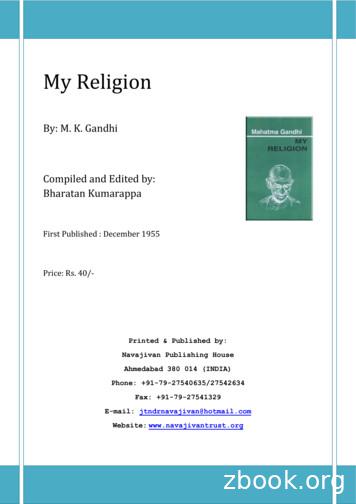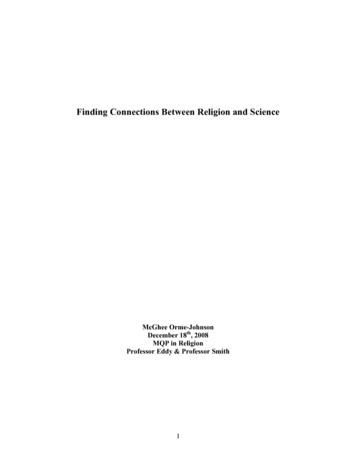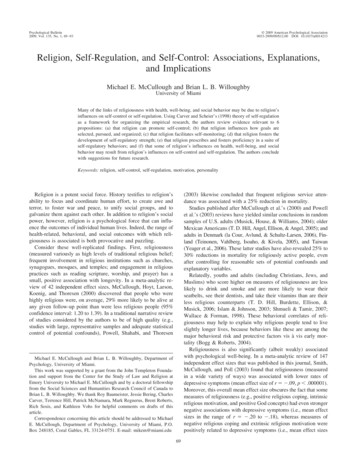Religion: What It Is, How It Works, And Why It Matters .
Copyright, Princeton University Press. No part of this book may bedistributed, posted, or reproduced in any form by digital or mechanicalmeans without prior written permission of the publisher.IntroductionThe God of old bids us all abide by His injunctions.Then shall we get whatever we want, be it white or red.—TRA D ITI ONAL G H ANAIAN A K AN P RAY ER ON TAL K I N G D RU M S1See, I set before you today life and prosperity, death and destruction.For I command you today to love the Lord your God, to walk inobedience to him, and to keep his commands, decrees and laws; then youwill live and increase, and the Lord your God will bless you in the landyou are entering to possess.But if your heart turns away and you are not obedient,and if you are drawn away to bow down to other gods andworship them,I declare to you this day that you will certainly be destroyed.— D EUTERONO M Y 3 0 :1 5 –17Anyone who wants to understand the world today has got to understandreligion. The majority of people in the world affiliate with a religion, andmany do so fervently. Religious practices have been a part of homo sapienslife since the beginning of our discernable history.2 No human society has1. Quoted in Jerome Rothenberg and Diane Rothenberg. 1983. Symposium of the Whole.Berkeley: University of California Press. P. 137.2. Colin Renfrew and Iain Morley, eds. 2009. Becoming Human. Cambridge: Cambridge1For general queries, contact webmaster@press.princeton.eduSmith.indb 14/25/2017 7:36:18 AM
2 Copyright, Princeton University Press. No part of this book may bedistributed, posted, or reproduced in any form by digital or mechanicalmeans without prior written permission of the publisher.I ntro d u c ti o nexisted that did not include some religion. A broad array of religions existsaround the globe today, with a single religion dominating society in someplaces, while in others many traditions mix, morph, and clash. Efforts bysome modern states to do away with religions have failed. Though thin andweak in some regions, religion is robust and growing in other parts of theworld. On top of their relevance to individuals, contemporary religions produce major political, cultural, economic, and social consequences aroundthe globe. Human life simply does not boil down to secular economics andpolitics. Understanding many major problems today is impossible withoutaccounting for religion’s influences. Neither can we appreciate much that iswidely considered good in the world without taking religious factors intoaccount. Academic scholars and elites often ignore religion. In doing so,they risk ignorance about a crucial part of human life that frequently affectsthe political, economic, family, military, and cultural phenomena they careabout. When we understand religion and its role in societies, we can betterunderstand our world.This book explains in general theoretical terms what religion is, how itworks, and why and how religion influences people and societies. Offeredhere is not a comparative study of various religions, but a social scientifictheory of religion that helps make sense of all religions. Readers will learnnot about the particular beliefs and practices of some specific religions, butabout the nature of religious beliefs and practices per se that make religionswhat they are. By learning to approach and understand religion theoretically, readers will become equipped to grasp and explain any specific religion that may interest them.Real- life events in recent decades have made clear that religion remainsa crucial feature of human life. One cannot glance at the news without seeing religion’s impact on local activities, national politics, and internationalwar and peace. Yet social scientists who study religion seem somewhat constrained in their ability to explain religion well. Some are tired from frustrating theoretical debates; others focus on trivial rather than important topics;and yet others doubt whether religion as a subject matter even exists to bestudied. My own field of sociology of religion seems like it could use there- energizing of a better theoretical vision that stimulates new work. Soalthough today we all need to understand religion well, the available theoretical resources may not be up to the task. In this situation, my purpose is niversity Press; Robert Bellah. 2011. Religion in Human Evolution. Cambridge, MA: HarvardUBelknap.For general queries, contact webmaster@press.princeton.eduSmith.indb 24/25/2017 7:36:18 AM
Copyright, Princeton University Press. No part of this book may bedistributed, posted, or reproduced in any form by digital or mechanicalmeans without prior written permission of the publisher.I ntro d u c ti o n3to advance an approach that explains religion clearly in order to enhanceunderstanding and help generate fruitful new research.The Argument in BriefI develop this book’s theory of religion by answering five basic questions,which provide the titles of its five chapters. First I explain what religion is.Then I describe what causal powers religion generates for influencing people, institutions, and cultures. Next I examine the key cognitive processinvolved in practicing religion, namely, explaining events by attribution tothe influence of superhuman powers. I then explore why people are religious (or not), and in particular why humans seem to be the one animalspecies on earth that practices religion. Finally, I consider the question ofreligion’s future fate in modern societies.I begin in chapter 1 by defining what religion is. Religion, I will argue, isbest defined as a complex of culturally prescribed practices that are basedon premises about the existence and nature of superhuman powers. Thesepowers may be personal or impersonal, but they are always superhuman inthe dual sense that they can do things that humans cannot do and that theydo not depend for their existence on human activities. Religious peopleengage in complexes of practices in order to gain access to and communicate or align themselves with these superhuman powers. The hope involvedin the cultural prescribing of these practices is to realize human goods andto avoid bads, especially (but not only) to avert misfortunes and receiveblessings and deliverance from crises. Key to this definition is the dual emphasis on prescribed practices and superhuman powers, which distinguish itfrom other approaches that focus instead on people’s beliefs or meanings(rather than practices) and on the supernatural, sacred, transcendent, divine, or ultimate concern (rather than superhuman powers). This emphasishelps to avoid problems that plague other theories of religion.This approach to religion distinguishes between a conceptual definitionof what religion is and the myriad reasons why people do religion. The conceptual definition, we will see, references public traditions, institutions, andcultural prescriptions. The empirical reasons why people actually do religion, by contrast, often involve not just the desire to seek help from superhuman powers but also a variety of other subjective motivations, some ofwhich actually may not be particularly religious, such as wanting to meetfriends at prayer services. I will argue that we cannot define religion conceptually by the reasons people practice religion, any more than we canFor general queries, contact webmaster@press.princeton.eduSmith.indb 34/25/2017 7:36:18 AM
4 Copyright, Princeton University Press. No part of this book may bedistributed, posted, or reproduced in any form by digital or mechanicalmeans without prior written permission of the publisher.I ntro d u c ti o ndefine politics by adding up people’s reasons for voting for certain candidates in elections. We need to differentiate theoretically between what religion itself is and why people do it, even if the answers to these questionsoverlap. Doing so maintains theoretical clarity and opens up many interesting research questions.When people practice religion for whatever reasons, I argue in chapter2, they create a variety of new social features and powers that are able toinfluence people’s lives and the world. These include things like new formsof identity, community, meaning, self- expression, aesthetics, ecstasy, socialcontrol, and legitimacy. I call these religion’s “causal capacities,” things religions can do (again, distinct from what religion is). These causal capacities,we will see, are secondary, dependent, and derivative aspects of religion’score nature. Nevertheless, they are crucial in forming the character of specific religious traditions. The goods they offer are also some of the reasonswhy many people practice religion. And such causal capacities explain howand why religions exert influence on people’s actions and in cultures andsocial institutions—in ways that, I will argue, are far more extensive anddiverse than many observers realize. Why does religion matter? For socialscientists, part of the answer is that religion can make a difference, sometimes a big one, in how people’s lives and the world operate.Having described what religion is and what it can do, I explore in chapter 3 the particular human mental process upon which the practice of religion depends: the making of “causal attributions” to superhuman powers.This simply refers to religious people coming to believe that certain thingshappen (or don’t) in life because of superhuman powers. They can includeboth obviously religious outcomes (like feeling God’s forgiveness) andmore worldly ones (like a bountiful harvest); they can range from the profound (a miraculous healing from a fatal disease) to the seemingly trivial(remembering the right answer on a quiz). What matters here is that peopleattribute some event or condition at least partially to the influence of superhuman powers. And since religious people do not always get what theywant, we will also examine the various ways that people interpret the successes (or failures) of their religious practices. Along the way, we will consider questions about the nature of “religious experiences,” miracles, andother kinds of superhuman interventions in human life. We will also exploresome common cognitive biases that routinely influence human thinking, tobetter understand how and why people can easily attribute ordinary lifeoutcomes to the influence of superhuman powers.For general queries, contact webmaster@press.princeton.eduSmith.indb 44/25/2017 7:36:18 AM
Copyright, Princeton University Press. No part of this book may bedistributed, posted, or reproduced in any form by digital or mechanicalmeans without prior written permission of the publisher.I ntro d u c ti o n5I then turn in chapter 4 to investigate why humans are even religious inthe first place. Why are there any religions at all? And why are humans theonly species on earth that practices religion? I will argue that the answer liesin humans’ unique possession of a complicated combination of natural capacities and limitations. Natural, unique human capacities make it possiblefor humans to conceive of and believe in superhuman powers that are notimmediately present, and to find ways to try to access their help. And humanity’s natural limitations provide good motivations for seeking such help.The uncomfortable existential space created by the collision of amazinghuman powers and severe human incapacities provides the grounds inwhich religions germinate, grow, and flourish. Seeking the help of superhuman powers to live in that difficult space—and to realize humanly good andavoid bad things within it—is the central reason why people practice religion. Humans also often practice religion because they enjoy the secondarycausal capacities that religion affords. I will additionally reference a largebody of recent research in the cognitive science of religion to suggest thatthe regular operation of ordinary human perceptions, the human brain, andcommon human cognitive processes work together to make religion a natural and fairly effortless way for people to think about and live in the world.Religion actually comes quite naturally, it turns out, given human neurobiology, cognition, and psychology.Finally, in chapter 5 I answer the question of religion’s future first by suggesting that until human nature fundamentally changes, many humans willalmost certainly want to continue to practice religion; that humans will continue to generate new religions; that religions will continue to be internallytransformed over time; and that some religions will grow in size, strength,and significance, while others will decline. Predictions about the inevitabledecline and possible disappearance of religion in modern society are incorrect. However, such “secularization theories” are not completely wrong oruseless. Properly appropriated, they offer valuable insights into social causalmechanisms that decrease religious belief and practices. But to understandhow these matters really work, I argue, we have to discard the simplisticassumption that secularization theory is either right or wrong. Instead, weneed to re- conceptualize our analyses to recognize the variety of causalmechanisms that operate simultaneously, in sometimes contradictory andsometimes reinforcing ways, to produce different religious outcomes, depending on the specific historical conditions and social contexts of particular situations. In short, our understanding of religion’s fate in modernity (orFor general queries, contact webmaster@press.princeton.eduSmith.indb 54/25/2017 7:36:18 AM
6 Copyright, Princeton University Press. No part of this book may bedistributed, posted, or reproduced in any form by digital or mechanicalmeans without prior written permission of the publisher.I ntro d u c ti o nanytime, actually) needs to take into account greater complexity, contingency, and path- dependency than has been typical in the past.That summarizes the main argument of the chapters that follow. Theremainder of this introduction focuses on related philosophical and meta- theoretical issues, to which scholars should attend. Non- scholarly readerswho might get bogged down in philosophy, however, may want to skipahead to read the last paragraph of this introduction (which makes a pointimportant for everyone) and then proceed to chapter 1.Theoretical InfluencesMy argument in this book is shaped by three key theoretical influences:first, a substantive, practice- centered view of religion; second, the philosophy of critical realism; and, third, the social theory of personalism. The firstof these is a view of religion that is defined substantively, in terms of themeanings of a type of actions, and focuses on human practices before beliefs, following the previous work of Martin Riesebrodt and Melford Spiro.3This approach understands religions as culturally prescribed systems ofpractices seeking to access superhuman powers in order to realize humangoods and for help in solving problems, both minor and profound. I believethis is the best way to understand religion, but it needs elaboration.4 I agreewith Stephen Bush that the triad of religious experience, meaning, and3. Martin Riesebrodt. 2010. The Promise of Salvation: A Theory of Religion. Chicago: University of Chicago Press; Melford Spiro. 2003 [1966]. “Religion: Problems of Definition and Explanation.” Pp. 187–222 in Spiro. Culture and Human Nature. New Brunswick, NJ: Transaction. Myargument also closely parallels that of Kevin Schilbrack. 2014. Philosophy and the Study of Religions. Malden, MA: Wiley Blackwell. Pp. 115–148, which I unfortunately did not discover untilthis book was nearly completed.4. I use the word “best” here intentionally, as an alternative to the triumphalist “the onlytrue,” on the one hand, and the relativistic “just another interesting and useful,” on the other. Allhuman knowledge is fallible and can be improved upon, yet some ideas are better than others.“Best” here combines both a commitment to the defensible preferability of an idea, with an openness to future revisions, improvement, or perhaps replacement, something like “the approachthat the best currently available reasoning about evidence compels us to affirm over others.”Some have suggested that I claim merely that my argument is internally logically coherent withthe first principles of critical realism, not true or more accurate than other approaches. But acritical realist, operating with an “alethic” theory of truth (William Alston. 1996. A Realist Conception of Truth. Ithaca: Cornell University Press), cannot settle for a mere “coherentist” epistemology defended by the likes of W.V. Quine (1978. The Web of Belief. New York: McGraw- Hill).Theories need to be not merely internally coherent, but adequate to reality, as conceptual representations of what exists and how it works (see Christian Smith. 2010. What Is a Person? Chicago:University of Chicago Press. Pp. 209–212).For general queries, contact webmaster@press.princeton.eduSmith.indb 64/25/2017 7:36:18 AM
Copyright, Princeton University Press. No part of this book may bedistributed, posted, or reproduced in any form by digital or mechanicalmeans without prior written permission of the publisher.I ntro d u c ti o n7power needs to be retained and integrated in a new way, and that religiouspractices provide the right theoretical framework for doing so.5 Riesebrodtand Spiro, for their parts, pointed us very far in the right direction. But Ithink their ideas need developing and expressing in ways more accessibleto wider audiences.The second theoretical influence is the philosophy of “critical realism.”Behind all theoretical and empirical scholarship stands some philosophy ofreality and human knowledge (“metaphysics” and “epistemology”), and inthe deeper background there usually stands a philosophy of what is goodand bad, right and wrong (ethics). Many social scientists do not pay attention to the philosophies that underlie their work, but that does not decreasetheir influence. It only means they are less visible and acknowledged. Certain general background philosophies have especially influenced the studyof religion.6 While all have some valuable insights to contribute, each I thinkis inadequate by itself (and in some ways highly misleading and unhelpful).A better alternative is critical realism.7 Many existing works explain andadvocate critical realism, and I need not repeat their arguments here. A fewcomments should suffice to help make sense of what follows.Critical realism tells us to think of all science as learning about what exists and how and why it works. What exists is a matter of “ontology,”8 and5. Stephen Bush. 2014. Visions of Religion. New York: Oxford University Press.6. These are positivist empiricism, hermeneutical interpretivism, postmodern deconstructionism, and pragmatism. Hermeneutical interpretivism is correct in most of its basic claims;however, it is often insufficient in not taking seriously enough the scholarly aim of understandingnot only meanings but also causal influences in human life. One important account of this position—drawing out, problematically, in my view, some Wittgensteinian ideas to certain wrongconclusions—is Peter Winch. 1958. The Idea of a Social Science and Its Relation to Philosophy.London: Routledge. Also see Phil Hutchinson, Rupert Read, and Wes Sharrock. 2008. There IsNo Such Thing as a Social Science. Surrey, UK: Ashgate. Positivist empiricism and postmoderndeconstructionism are more problematic.7. Critical realism is a meta- theory or philosophy of science, including social science, not aspecific theory of religion or anything else. It is not a general explanation of how a particular partof human social life works, but rather a higher- order system of ideas and claims about reality, howit is ordered, and how it functions that creates a realistic framework within which good specifictheories can be constructed. It is possible to develop different theories about any given topicwithin the crit
religion. The majority of people in the world affiliate with a religion, and many do so fervently. Religious practices have been a part of homo sapiens life since the beginning of our discernable history.2 No human society has 1. Quoted in Jerome Rothenberg and Diane Rothenberg. 1983.
FAMILY AND RELIGIOUS STUDIES SYLLABUS (FORMS 1 – 4) 9 Religion and the Liberation Struggle-Chimurenga/Umvukela Religion, Rights and Social Responsibility Religion and Conflict management 7.0 SCOPE AND SEQUENCE 7.1 TOPIC 1: RELIGION SUB-TOPIC FOR M 1 FORM 2 FORM 3 FORM 4 Concept of Religion Definition, types and c haracteristics of religion Different religions in Zimbabwe .
religion. However, religion cannot be defined except by the characteristics by which are found wherever religion itself is found.4 Nevertheless, the one aspect of religion that must be agreed upon, and is required to remotely be considered as religion, is that it is a belief system held by a group of
Religion which takes no account of practical affairs and does not help to solve them, is no religion. Young India, 7-5-'25, p. 164 Every activity of a man of religion must be derived from his religion, because religion means being bound to God,
Religion in the Schools Task Force guided this initiative.6 Overview of Guidelines Part One addresses why it is important to teach about religion, and Part Two outlines ways to teach about religion in constitutionally sound ways. Part Three is an overview of approaches to teaching about religion
Curriculum Guide Revised December 2017. Course Offerings Department 9th 10th 11th 12th Religion Religion 1 Religion 2 Religion 3 Religion 4 Religion 4/ Leadership . Freshmen will become familiar with the Common Application to understand the elements considered by colleges for admission.
Religion and science serve different purposes to different people. As such, Latour’s view is only one way of describing the purposes of religion and science, and there could be other views that allow for more of a compliment between religion and science. I would suggest that religion and science have different purposes than what
Keywords: religion, self-control, self-regulation, motivation, personality Religion is a potent social force. History testifies to religion s ability to focus and coordinate human effort, to create awe and terror, to foster war and peace, to unify social groups, and to galvanize them against each other. In addition to religion s social
tween religion and culture. Schleiermacher, addressing the “cul-tured despisers” of religion, described it as “the profoundest depths whence every feeling and conception receives its form.”1 Tillich, in a similar vein, wrote that “religion is the substance of culture, [while] culture is the form of religion.”2 The roots of the























